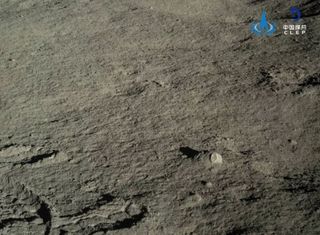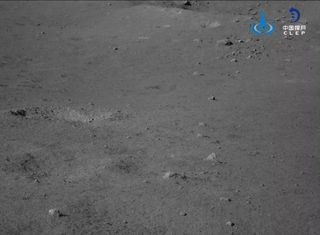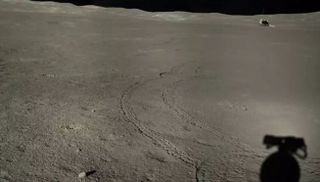On the far side of the moon, Chinese lander and rover begin 15th lunar day
And both are still in good shape.

China's Chang'e 4 mission has entered its 15th lunar day of work on the far side of the moon, with both the Chang'e 4 lander and the Yutu 2 rover still in good condition.
The mission made a historic, first-ever landing on the lunar far side in January 2019, and its two surface craft are still going strong, despite the moon's harsh radiation and temperature environment.
Yutu 2 awoke on Feb. 17 following sunrise, with a preset plan to continue driving northwest and then southwest across the floor of Von Kármán Crater. Back on Earth, the Yutu 2 drive team has implemented measures such as wearing masks to combat the spread of the COVID-19 coronavirus outbreak.
Related: Chang'e 4 in pictures: China's mission to the moon's far side

The rover has covered a total of 1,204 feet (367 meters) during the mission, according to the China National Space Administration (CNSA). Yutu 2's predecessor, the Chang'e 3 mission's Yutu rover, lost mobility during its second lunar day. (One lunar day is about two Earth weeks long, as is a lunar night.)
The Chang'e 4 lander, meanwhile, resumed its own activities 13 hours after Yutu 2. Science instruments on both spacecraft are working well, the CNSA said.
Communications between teams in China and the awakening spacecraft on the far side of the moon, which never faces the Earth, were facilitated by the Queqiao relay satellite, which operates in a halo orbit around a special point beyond the moon.
Get the Space.com Newsletter
Breaking space news, the latest updates on rocket launches, skywatching events and more!

The solar-powered Chang'e 4 lander and Yutu 2 rover had earlier completed their 14th lunar day of science and exploration on Jan. 31, ahead of sunset over the landing area.
These two spacecraft spent more than two weeks in a dormant state to protect against temperatures that can drop as low as minus 310 degrees Fahrenheit (minus 190 degrees Celsius) during lunar night.

Last month, China released a huge batch of Chang'e 4 data, including amazing high-resolution images from the mission. During lunar Day 13, back in December, Yutu 2 spotted and analyzed what could be rocks much younger than their surroundings.
While Chang'e 4 continues operations and sets records, China is set to launch another ambitious lunar mission late this year. Chang'e 5, a sample-return mission, will collect around 4 lbs. (2 kilograms) of samples from Oceanus Procellarum on the moon's near side before returning to Earth.
- Photos from the moon's far side! China's Chang'e 4 lunar landing in pictures
- NASA probe spots China's Chang'e 4 lander on far side of the moon (photo)
- Moon photos by China's Chang'e 2 lunar orbiter (gallery)
Follow Andrew Jones at @AJ_FI. Follow us on Twitter @Spacedotcom and on Facebook.
OFFER: Save at least 56% with our latest magazine deal!
All About Space magazine takes you on an awe-inspiring journey through our solar system and beyond, from the amazing technology and spacecraft that enables humanity to venture into orbit, to the complexities of space science.
Join our Space Forums to keep talking space on the latest missions, night sky and more! And if you have a news tip, correction or comment, let us know at: community@space.com.

Andrew is a freelance space journalist with a focus on reporting on China's rapidly growing space sector. He began writing for Space.com in 2019 and writes for SpaceNews, IEEE Spectrum, National Geographic, Sky & Telescope, New Scientist and others. Andrew first caught the space bug when, as a youngster, he saw Voyager images of other worlds in our solar system for the first time. Away from space, Andrew enjoys trail running in the forests of Finland. You can follow him on Twitter @AJ_FI.

